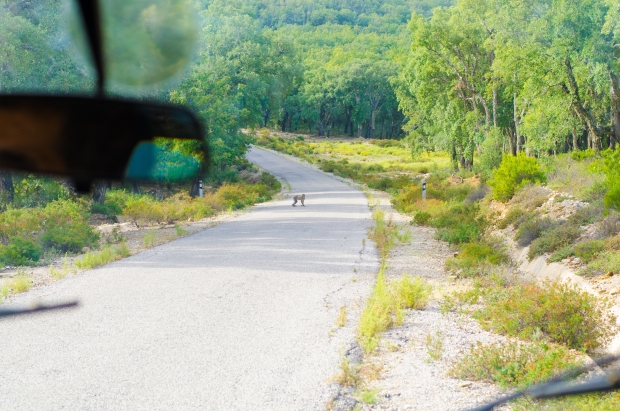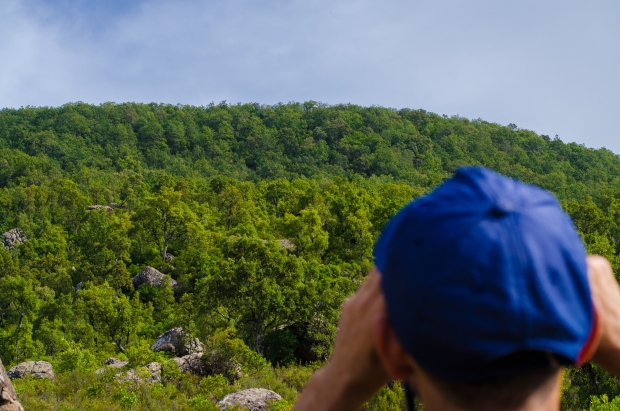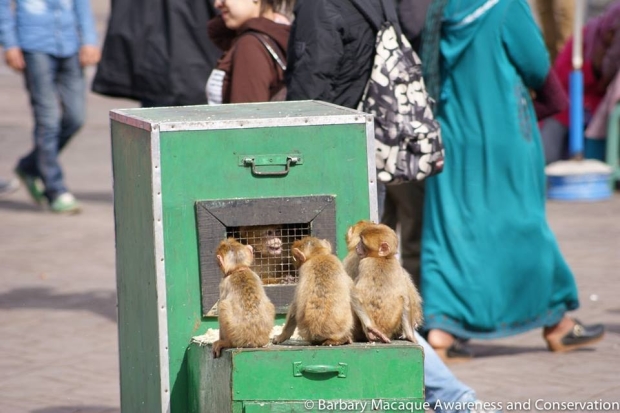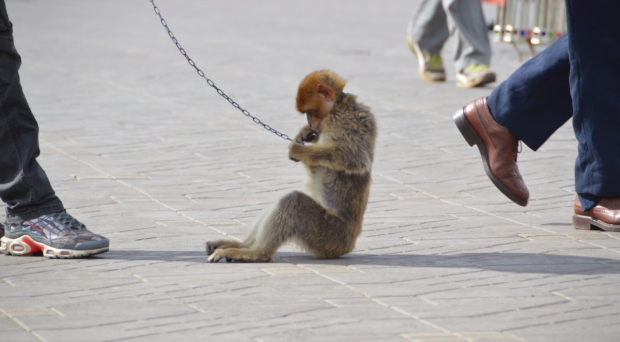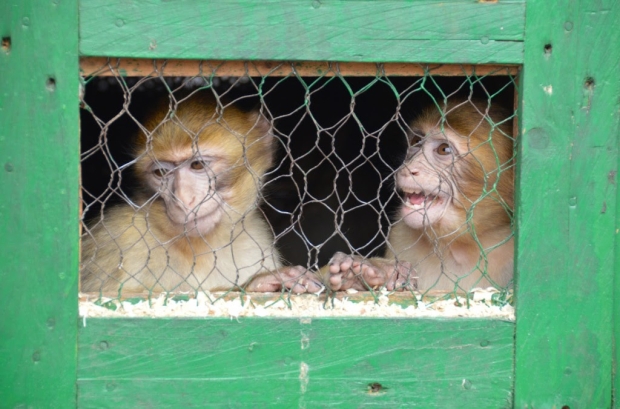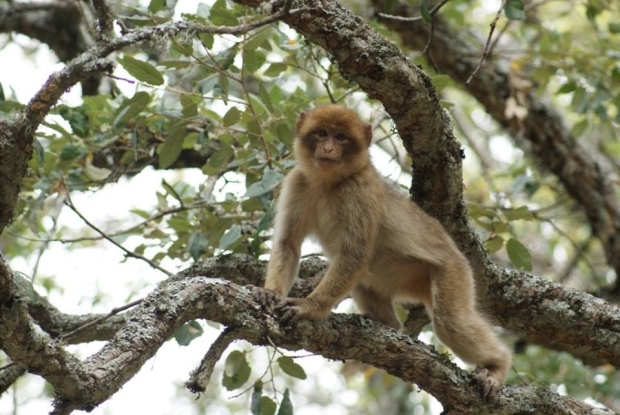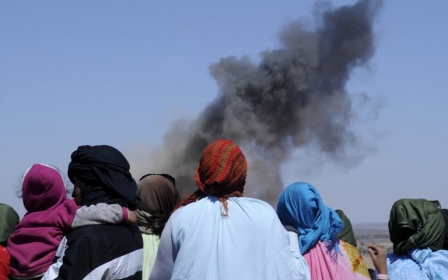Saving Morocco’s macaques: More than just monkey business

RIF MOUNTAINS, Morocco - The team went back and forth peering between pairs of binoculars and cameras, taking brief pauses to scribble in their notebooks. They were surveying a grassy opening in Bouhachem Forest, in the highlands of Morocco’s Rif Mountains, for Barbary macaques, the monkeys native to North Africa. On this occasion they tallied a sum of 60 macaques crossing the road that hugs the perimeter of the park.
“We estimate that there are around 2,000 macaques living in this area,” said Dr Sian Waters of Barbary Macaque Awareness and Conservation (BMAC), a group who monitors Morocco’s macaque population. “But it is hard to know exactly how many of them are here because they are so wary of people and the terrain is so difficult.”
The Barbary macaque is the only macaque species that dwells outside of Asia. No other primates are native to the north of the Sahara Desert.
In Morocco, their communities are concentrated in the Middle Atlas and Rif Mountains in the north of the country, though it is believed that they once lived throughout Morocco when the number of macaques was higher. Macaques are also found in neighbouring Algeria and were introduced to the peninsula of Gibraltar in 1740.
The 140-acre Bouhachem Forest is one of the habitat zones where macaques are not socialised to human presence, making encounters with them rare. Unlike the forests in Ifrane where the monkeys have become accustomed to visitors, the macaques of this region will flee when approached. Yet their isolation from human settlement in the dense interior of the Rif’s coarse mountain terrain has not prevented the number of macaques from declining.
Barbary macaques are considered endangered according to the IUCN Red List of Threatened Species. In 1975, the population of macaques in Morocco was about 17,000, but by 2004 the figure has dropped to below 10,000. Today the number has fallen to as low as 5,000, although exact figures do not exist. And current trends project the macaque population to continue decreasing from threats such as deforestation and poaching.
Battling the macaque market
The international ban on the trade of Barbary macaques was uplisted this past summer, strengthening existing legislation seeking to put an end to the market for the species, who remain favourites among exotic pet collectors.
“We’ve seen Barbary macaques being kept as pets in Egypt, and as far away as Dubai,” says Waters, adding that much of the trade is carried out through online animal bazaars and even on Facebook and Instagram pages. Most are captured during infancy and sell on average between 100-200 euros.
Over the last several years, Morocco’s High Commission for Water and Forests has strengthened Morocco’s domestic legislation on macaque conservation. It has granted macaques a protection status that prohibits “the capture, hunting, possession, sale and hawking” of the animal. Plans of action also consider how to improve local ecosystems, raise public awareness and implement restoration programmes.
But in Morocco, where macaques are fixtures at public squares frequented by tourists like Marrakech’s Jmaa El Fna, authorities are not always consistent at enforcing these regulations. They view macaques as part of Morocco’s cultural history, and are therefore less likely to crack down on opportunistic individuals who tour the macaques around city centres for photo opportunities and other forms of entertainment.
One entertainer from Meknes told Middle East Eye that authorities have yet to confiscate his macaques despite being in violation of the law, which includes a 1000 MAD penalty ($99). Though he added it would be rather easy to find replacements if they were taken off him.
“It is easy to buy these monkeys around here if you know the right people. You can even do it yourself if you know what you are doing and are careful.”
Waters and her colleagues have backtracked their stance on confiscation of photo prop macaques for this reason, worrying that they were contributing to the market for macaques.
“We started to become more concerned that by taking away macaques we were creating a greater demand for them to be captured or sold.”
'We started to become more concerned that by taking away macaques we were creating a greater demand for them to be captured or sold'
She adds that it is a common misconception among people that by purchasing macaques from shopkeepers or entertainers they are doing the animals a favour.
“People see the living conditions of macaques held in captivity and think that by taking them away that they are helping or rescuing them when they actually may be making the problem worse because they increase the demand.”
Many who hold macaques will look to sell them before they mature to full size and become unmanageable. The macaques who do not find sympathetic buyers are then typically returned to the forest.
With few exceptions, dumped macaques do not acclimatise to life back in the wilderness after spending time in captivity. Those who release them back into the wild are relegating them to an inevitable death that can be slow and cruel. In some cases, former captive macaques will even become aggressive and hostile, leading to skirmishes with their peers and people.
Villagers take up critical role
Persuading residents in these mountain villages of the pressing need to end macaque poaching and trafficking was a challenge at first. The BMAC has had to be careful to avoid a common mistake made by wildlife protection groups that appear to value endangered wildlife species over the people in local communities.
“We cannot approach people and tell them that they should do this or that. It isn’t effective, and it also comes off sounding a bit colonialist,” Waters remarks.
'We cannot approach people and tell them that they should do this or that. It isn’t effective, and it also comes off sounding a bit colonialist'
What has worked is a patient approach of building relationships with rural residents through public outreach programmes that address the needs of rural communities.
Working with communities
The group now arranges health clinics by bringing a health outreach team out to villages where healthcare services are non-existent. They have also run programmes to vaccinate stray dogs to protect people and domestic animals against rabies, as well as a series of workshops to build villagers’ capacity to improve their lives themselves.
Today, villages who share the forests with macaques play a pivotal role in helping BMAC realise its conservation goals. They employ a handful of local shepherds who monitor areas throughout the park while herding their goats and sheep.
Shepherds watch
In addition to the intimate knowledge that shepherds have of the surrounding area, they are trained to count macaques they come across according to age and sex, and track their location using a GPS system. The data they collect gives the small team of the BMAC the tip-offs they need to focus their surveying of the region to specific zones of the forest, which is too large for the small team to scan alone.
Today, the villages who share the forests with macaques play a pivotal role in helping BMAC realise its conservation goals
On the day Middle East Eye visited, the team travelled to the small village of Slalem in hopes of recruiting a new shepherd for an area of a mountain where they know macaques are living. It is a site the team has surveyed infrequently, where crowded trees and steep hillsides make the area almost impenetrable unless explored on foot. Shepherds know these areas intimately, and the more that shepherds are employed, more ground can be covered, and more macaque groups can be monitored.
In return for the knowledge and support provided by shepherds, BMAC pays a salary to supplement their annual incomes.
“It gives them and their families a steady supplemental income, which can make a lot of difference in these poorer marginal villages,” says Waters.
The group is optimistic that its rural outreach programmes will continue developing positive relationships with village communities. Much has changed from a decade ago when attempts to strike up discussions about the macaques would yield responses of jokes and banter.
“I was sometimes laughed at because I took an interest in the monkeys,” recalls Ahmed Chetwan, a former shepherd who is now a project assistant with BMAC.
“But things are improving little by little. People in this area have an important relationship to nature and the environment, and when they start to see that wildlife is in danger, they start to understand that other changes are happening around them.”
Raising awareness
Meanwhile, in nearby Tetouan, where the day-to-day connection to nature among city dwellers is more distant, the team has learned that simply making information about macaques available to the public is the best means to raise awareness.
“A villager would probably never take in a macaque as a pet, but they do in cities. They are both ignorant of the harm that captivity causes to macaques, as well as what captivity really entails. They agree to take in a macaque as a pet thinking it will stick around for just four or five years, unaware that they can live up to 20 years,” says Waters.
To combat these misconceptions about macaques prevalent in cities, BMAC organises local soccer tournaments, public exhibitions, and visits to schools across the country for the purpose of raising awareness and supplying general information. The campaigns have been surprisingly successful, surpassing the expectations of the group, explains Waters, as they initially assumed the public would find the information uninteresting.
“There is a genuine interest wherever we go. People not only in Tetouan, but from all around Morocco sometimes are not even aware that macaques are unique to the country, so some Moroccans will begin to take more pride in the creatures after our events.”
The group believes that mobilising public awareness in both urban and rural areas is essential to realising their conservation initiatives in a sustainable manner. It has taken nearly a decade of patience and dedication, but the group has witnessed a significant swing in public opinion, says Waters.
“We do genuinely think that all of our hard work has made a difference. We have achieved many of the goals we set for ourselves, even if it has required several years to do.”
They now hope to see their efforts begin to reverse the decline that macaques have faced over the last few decades for a brighter long-term future.
New MEE newsletter: Jerusalem Dispatch
Sign up to get the latest insights and analysis on Israel-Palestine, alongside Turkey Unpacked and other MEE newsletters
Middle East Eye delivers independent and unrivalled coverage and analysis of the Middle East, North Africa and beyond. To learn more about republishing this content and the associated fees, please fill out this form. More about MEE can be found here.


